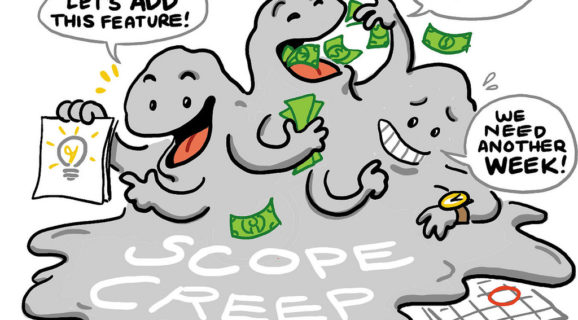
4 ways an effective Project Manager controls scope creep
A project’s scope describes the output or outcomes of the project, and one of the elements of the triple constraint that can destroy project success is project scope creep. This happens naturally, as the customer adds ‘would-likes’ to the original project scope. If the Project Manager allows this to happen, it will have an impact on the project – either by increasing project costs, or delivery time, or both. To keep a project that has suffered scope creep on time and within budget, the only other alternative is to reduce quality. Clearly, none of these outcomes are satisfactory, so it is incumbent upon the Project Manager to manage project scope and resist scope creep.
In this article, you’ll learn the four ways in which Project Managers manage project scope.
1. Project scope management starts immediately
It’s imperative that the Project Manager understands the client’s requirements from day one. This includes required outcomes, priorities and ambitions for the project. It is essential that the Project Manager asks all questions necessary, and this includes deliverables and functionality.
Scope must be agreed before the project starts, and complexity must be considered to properly assess resource requirements and produce a viable timeline. In PRINCE2, the Project Manager would develop the project timeline in line with project stages.
2. Include a process to address scope creep
Understanding that project scope is likely, a Project Manager should provide a process by which scope can be evolved. In many project methodologies, there will be a process assigned for making changes to project scope. There should be a limited number of people able to request changes, and fewer still able to agree them.
PRINCE2 doesn’t recognise scope creep, as the parameters of the project are agreed in detail at the outset. However, it does recognise that there will be controls and breakpoints during a project’s lifetime, and this enables the project to be managed within a contractual framework. It also recognises that, as a project progresses, there may be changes needed to deal with issues that arise, and these are dealt with by the procedures laid down in the PRINCE2 change theme.
3. Good Project Managers say “no”!
While some scope creep may be agreed and built into the project, Project Managers cannot give the go-ahead for all requests for extras. Some change requests may hold up ensuing work packages, and this could have a large, detrimental impact on the overall project.
A good Project Manager knows when to say no and point out the cost, time and quality effects of requested add-ons.
4. Alternatives that may be offered
When extras are requested and labelled as essential, the Project Manager may offer trade-offs such as:
- Delete some functionality to add the new functionality
- Start a list of backlogged features that will be given priority should the original scope come in ahead of budget or within time
- Increase the price of the project to enable the add-ons to be included
Scope creep has no upside
Scope creep has no upside. It invariably increases project budget and timeline. It increases the workload of the Project Manager and project teams, and where supplies, materials and manpower have been reserved to fit with the project timeline, project scope can have a major effect on cost, time and quality.
Project creep is one of the hardest elements of the triple constraint to manage. Project Managers want to please their clients. But a good Project Manager will hold firm and help direct the project to a successful outcome, based upon original scope and desired project outcomes.
To discover how focused project management using PRINCE2 methodology can help your project be successful, contact Your Project Manager:

